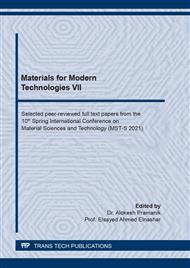[1]
W. Miller, L. Zhuang, J. Bottema, A. Wittebrood, P. De Smet, A. Haszler, A. Vieregge, Recent development in aluminum alloys for the automotive industry, Materials Science and Engineering: A 280 (1) (2000) 37-49.
DOI: 10.1016/s0921-5093(99)00653-x
Google Scholar
[2]
J. Hirsch, Recent development in aluminum for automotive applications, Transactions of Nonferrous Metals Society of China 24 (7) (2014) 1995-2002.
DOI: 10.1016/s1003-6326(14)63305-7
Google Scholar
[3]
K. Seong-Jong, J. Seok-Ki, H. Min-Su, P. Jae-Cheul, J.-Y. Jeong, S.-O. Chong, Mechanical and electrochemical characteristics in sea water of 5052-O aluminum alloy for ship, Transactions of Nonferrous Metals Society of China 23 (3) (2013) 636-641.
DOI: 10.1016/s1003-6326(13)62510-8
Google Scholar
[4]
M. Bethencourt, F. Botana, M. Cauqui, M. Marcos, M. Rodrıguez, J. Rodrıguez-Izquierdo, Protection against corrosion in marine environments of AA5083 Al-Mg alloy by lanthanide chlorides, Journal of alloys and compounds 250 (1-2) (1997) 455-460.
DOI: 10.1016/s0925-8388(96)02826-5
Google Scholar
[5]
Y. Sakai, Current state and the future of aluminum alloy applications of rolling stock, Journal of Japan Institute of Light Metals 55 (11) (2006) 584-587.
Google Scholar
[6]
E. A. Starke Jr, J. T. Staley, Application of modern aluminum alloys to aircraft, in: Fundamentals of aluminum metallurgy, Elsevier, 2011, p.747–783.
DOI: 10.1533/9780857090256.3.747
Google Scholar
[7]
J. Immarigeon, R. Holt, A. Koul, L. Zhao, W. Wallace, J. Beddoes, Lightweight materials for aircraft applications, Materials Characterization 35 (1) (1995) 41-67.
DOI: 10.1016/1044-5803(95)00066-6
Google Scholar
[8]
T. Dursun, C. Soutis, Recent developments in advanced aircraft aluminum alloys, Materials & Design (1980-2015) 56 (2014) 862-871.
DOI: 10.1016/j.matdes.2013.12.002
Google Scholar
[9]
J. C. Williams, E. A. Starke Jr, Progress in structural materials for aerospace systems, Acta Materialia 51 (19) (2003) 5775-5799.
DOI: 10.1016/j.actamat.2003.08.023
Google Scholar
[10]
A. Heinz, A. Haszler, C. Keidel, S. Moldenhauer, R. Benedictus, W. Miller, Recent development in aluminum alloys for aerospace applications, Materials Science and Engineering: A 280 (1) (2000) 102-107.
DOI: 10.1016/s0921-5093(99)00674-7
Google Scholar
[11]
J. Zhi-bang, S. Dian-cheng, G. Yun-hua, Global advanced process technology of aluminum alloy plates for aircraft and aerospace, Light Alloy Fabrication Technology (2005).
Google Scholar
[12]
T. S. Srivatsan, S. Sriram, D. Veeraraghavan, V. Vasudevan, Microstructure, tensile deformation and fracture behavior of aluminum alloy 7055, Journal of materials science 32 (11) (1997) 2883-2894.
DOI: 10.1023/a:1018676501368
Google Scholar
[13]
C. Mondal, A. Mukhopadhyay, On the nature of T (Al2Mg3Zn3) and S (Al2CuMg) phases present in as-cast and annealed 7055 aluminum alloy, Materials Science and Engineering: A 391 (1-2) (2005) 367-376.
DOI: 10.1016/j.msea.2004.09.013
Google Scholar
[14]
L. Chen, Z.H. Li, S.H. Huang, X.W. Li, H.W. Yan, H.W. Liu, Y.A. Zhang, B.Q. Xiong, Microstructure evolution of 7055 aluminum alloy during multi-pass hot deformation and solution treatment process, Transactions of Materials and Heat Treatment 36 (12) (2015) 55-60.
Google Scholar
[15]
J.Z. Chen, Z. Liang, S.J. Yang, S.L. Dai, Effects of precipitates on fatigue crack growth rate of aa 7055 aluminum alloy, Transactions of Nonferrous Metals Society of China 20 (12) (2010) 2209-2214.
DOI: 10.1016/s1003-6326(10)60630-9
Google Scholar
[16]
J. Chen, L. Zhen, W. Shao, S. Dai, Y. Cui, Through-thickness texture gradient in AA7055 aluminum alloy, Materials Letters 62 (1) (2008) 88-90.
DOI: 10.1016/j.matlet.2007.04.074
Google Scholar
[17]
C. Fuguan, Z. Gang, T. Ni, L. I. Ruifeng, Inhomogeneity of properties of 7150-T7751 aluminum alloy thick plate, Chinese Journal of Materials Research 27 (2) (2013) 144-148.
Google Scholar
[18]
Zeng. Su-min, Disciplines of multiple factors affecting solution treating of aluminum alloy, Nonferrous Metals 3(1999).
Google Scholar
[19]
Li. Pei-yue, Xiong Bai-qing, Zhang Yong-an, Li. Zhi-hui, Temperature variation and solution treatment of high strength AA7050, Transactions of Nonferrous Metals Society of China 22 (3) (2012) 546-554.
DOI: 10.1016/s1003-6326(11)61212-0
Google Scholar
[20]
Chang. Jiang-yu, Chen. Song-yi, Chen. Kang-hua, Zhou. Liang, Yuan. Ding-ling, Numerical simulation and experimental investigation of rolling deformation inhomogeneity of 7056 aluminum alloy thick plate, Journal of Central South University (Science and Technology) (2018).
Google Scholar
[21]
S. Hong, H. Jeong, C. Choi, D. Lee, Deformation and recrystallization textures of surface layer of copper sheet, Materials Science and Engineering A-structural Materials Properties Microstructure and Processing 229 (1997)174-181.
DOI: 10.1016/s0921-5093(96)10818-2
Google Scholar
[22]
O. V. Mishin, B. Bay, D. J. Jensen, Through-thickness texture gradients in cold-rolled aluminum, Metallurgical and Materials Transactions A-physical Metallurgy and Materials Science 31 (6) (2000) 1653-1662.
DOI: 10.1007/s11661-000-0175-2
Google Scholar
[23]
Zhang. Xin-ming, Han. Nian-mei, Liu. Sheng-dan, Song. Feng-xuan, Zeng. Rui-lin, Huang. Le-yu, Inhomogeneity of texture, tensile property and fracture toughness of 7050 aluminum alloy thick plate, The Chinese Journal of Nonferrous Metals 20 (2) (2010) 202-208.
Google Scholar
[24]
Zhang. Zhi-hui, Zuo Yu-ting., Liu. Shu-feng, Study on microstructure, mixture and tensile property of 7B04 aluminum alloy plate along thickness direction, Journal of Chinese Electron Microscopy Society (2011).
Google Scholar
[25]
Wang. Shu-ming, Wang. Chao-qun, Du. Zhi-wei, Su. Ze-ming, Texture analysis for 7B04 Al alloy plate along thickness direction, Chinese Journal of Rare Metals 36 (3) (2012) 363-367.
Google Scholar
[26]
M. A. Meyersm, E. Ashworth, A model for the effect of grain size on the yield stress of metals, Philosophical Magazine 46 (5) (1982) 737-759.
DOI: 10.1080/01418618208236928
Google Scholar
[27]
K. K. Cho, Y. Chung, C. Lee, S. I. Kwun, M. Shin, Effects of grain shape and texture on the yield strength anisotropy of Al-Li alloy sheet, Scripta Materialia 40 (6) (1999) 651-657.
DOI: 10.1016/s1359-6462(98)00481-3
Google Scholar
[28]
Chen. Jun-zhou, Zhen. Liang, Dai. Sheng-long, Shao. Wen-zhu, Zhang Bao-you, Effects of grain shape and texture on the through-thickness yield strength of AA7055 aluminum alloy plate, Rare Metal Materials and Engineering 37 (11) (2008).
Google Scholar


